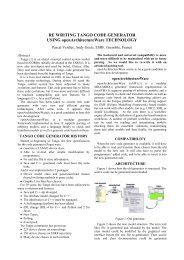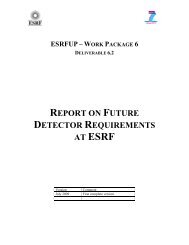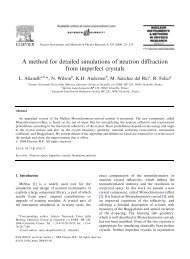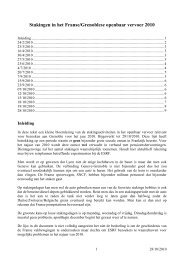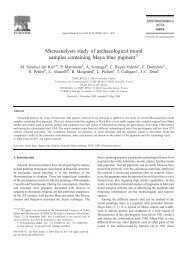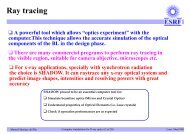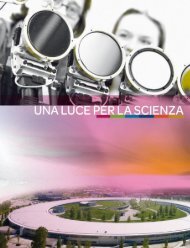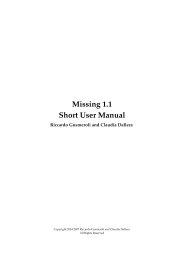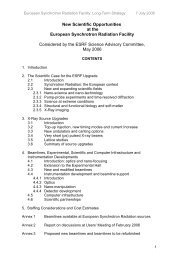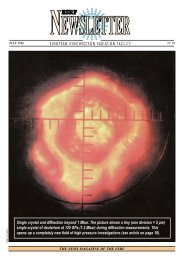A library for X-ray–matter interaction cross sections for X-ray ... - ESRF
A library for X-ray–matter interaction cross sections for X-ray ... - ESRF
A library for X-ray–matter interaction cross sections for X-ray ... - ESRF
Create successful ePaper yourself
Turn your PDF publications into a flip-book with our unique Google optimized e-Paper software.
1726<br />
Table 1<br />
Names, input and output of the x<strong>ray</strong>lib functions<br />
Category Function Returns<br />
Atomic data float AtomicWeight(int Z) atomic weight<br />
Cross <strong>sections</strong>:<br />
(cm 2 /g)<br />
Cross <strong>sections</strong>:<br />
(barn/atom)<br />
Differential<br />
unpolarized<br />
<strong>cross</strong> <strong>sections</strong>:<br />
(cm 2 /g/sterad)<br />
Differential<br />
unpolarized<br />
<strong>cross</strong> <strong>sections</strong>:<br />
(barns/atom/<br />
sterad)<br />
Form factors,<br />
scattering<br />
functions,<br />
momentum<br />
transfer<br />
float CS_Total(int Z, float E) Total <strong>cross</strong> section<br />
(photoionization+<br />
Rayleigh+<br />
Compton)<br />
float CS_Photo(int Z, float E) Photoionization<br />
CS<br />
float CS_Rayl(int Z, float E) Rayleigh CS<br />
float CS_Compt(int Z, float E) Compton CS<br />
float CS_FluorLine(int Z, int XRF CS<br />
line, float E)<br />
float CS_KN(float E) Klein-Nishina CS<br />
float CSb_Total(int Z, float E) Total <strong>cross</strong> section<br />
(photoionization+<br />
Rayleigh+<br />
Compton)<br />
float CSb_Photo(int Z, Photoionization<br />
float E)<br />
CS<br />
float CSb_Rayl(int Z, float E) Rayleigh CS<br />
float CSb_Compt(int Z, Compton CS<br />
float E)<br />
float CSb_FluorLine(int Z, int XRF CS<br />
line, float E)<br />
float DCS_Rayl(int Z, float E, Rayleigh DCS<br />
float theta)<br />
float DCS_Compt(int Z, Compton DCS<br />
float E, float theta)<br />
float DCS_Thoms(float Thomson DCS<br />
theta)<br />
float DCS_KN(float E, Klein–Nishina<br />
float theta)<br />
DCS<br />
float DCSb_Rayl(int Z, Rayleigh DCS<br />
float E, float theta)<br />
float DCSb_Compt(int Z, Compton DCS<br />
float E, float theta)<br />
float FF_Rayl(int Z, float q) Rayleigh<br />
float SF_Compt(int Z, float q) Incoherent<br />
scattering function<br />
float MomentTransf(float E, Momentum<br />
float theta)<br />
transfer (A^-1)<br />
Compton energy float ComptonEnergy(float E0,<br />
float theta)<br />
Absorption edges<br />
and transitions<br />
data<br />
Photon energy<br />
after Compton<br />
scattering<br />
Absorption edge<br />
energy [keV]<br />
Fluorescence line<br />
energy [keV]<br />
Fluorescence yield<br />
float EdgeEnergy(int Z, int<br />
shell)<br />
float LineEnergy(int Z,<br />
int line)<br />
float FluorYield(int Z,<br />
int shell)<br />
float JumpFactor(int Z, Jump ratio<br />
int shell)<br />
float RadRate(int Z, int line) Radiation rate<br />
float CosKronTransProb(int Z, Coster–Kronig<br />
int trans)<br />
transition<br />
probability<br />
It is possible to directly use the data from these<br />
tabulations <strong>for</strong> software applications. Both data sets come<br />
in a paper <strong>for</strong>mat, but it is possible to transcribe the data into<br />
electronic <strong>for</strong>mat. However, this is a very rigid approach,<br />
because it is not possible to verify and upgrade the data<br />
contributing to the fluorescence <strong>cross</strong> section, to get<br />
A. Brunetti et al. / Spectrochimica Acta Part B 59 (2004) 1725–1731<br />
accurate interpolated data (as the energy step <strong>for</strong> the<br />
tabulations is usually quite large), and use fluorescence<br />
lines other than the tabulated. Moreover, these references are<br />
quite old and although there is no new published compilation<br />
of XRF <strong>cross</strong> <strong>sections</strong>, there was in the last years<br />
remarkable progress in evaluated data, in particular <strong>for</strong><br />
photoionization <strong>cross</strong> section and anomalous scattering<br />
factors [2–4,7], and fluorescence yields [8]. It is there<strong>for</strong>e<br />
interesting to benefit from these new and more accurate data<br />
<strong>for</strong> the calculations of the XRF <strong>cross</strong> section. Thus, our<br />
approach is to evaluate XRF from its components, and not<br />
using published tables of XRF <strong>cross</strong> <strong>sections</strong>.<br />
An attempt to solve the problem of interfacing the data<br />
to the user is reported by Elam et al. [9]. They used a<br />
selection of previously published data. Although we found<br />
this tabulation extremely useful, we found difficulties in<br />
using it <strong>for</strong> XRF purposes. We present here a new database,<br />
which is loaded by a software package based on a shared C<br />
language <strong>library</strong>. Our interface functions are easily<br />
imported into languages used in scientific programming<br />
like C, Fortran and Python, and run in most operating<br />
systems. XRF data produced by our <strong>library</strong> are compared<br />
Krause data [5] and the differences are discussed. This<br />
<strong>library</strong> has been shown to be a valuable tool <strong>for</strong> several<br />
applications we developed that require a quick access to<br />
data, like fast spectroscopy reconstructions and Monte<br />
Carlo simulations.<br />
Fig. 1. Relative differences between the XRF <strong>cross</strong> <strong>sections</strong> (or partial<br />
photoionization <strong>cross</strong> section) using the full partial <strong>cross</strong> section tabulation<br />
(Scofield) and the jump approximation (in x<strong>ray</strong>lib), <strong>for</strong> Z=13 (top) and<br />
Z=80 (bottom).



